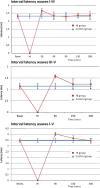Effect of neonatal asphyxia on the impairment of the auditory pathway by recording auditory brainstem responses in newborn piglets: a new experimentation model to study the perinatal hypoxic-ischemic damage on the auditory system
- PMID: 26010092
- PMCID: PMC4444324
- DOI: 10.1371/journal.pone.0126885
Effect of neonatal asphyxia on the impairment of the auditory pathway by recording auditory brainstem responses in newborn piglets: a new experimentation model to study the perinatal hypoxic-ischemic damage on the auditory system
Abstract
Introduction: Hypoxia-ischemia (HI) is a major perinatal problem that results in severe damage to the brain impairing the normal development of the auditory system. The purpose of the present study is to study the effect of perinatal asphyxia on the auditory pathway by recording auditory brain responses in a novel animal experimentation model in newborn piglets.
Method: Hypoxia-ischemia was induced to 1.3 day-old piglets by clamping 30 minutes both carotid arteries by vascular occluders and lowering the fraction of inspired oxygen. We compared the Auditory Brain Responses (ABRs) of newborn piglets exposed to acute hypoxia/ischemia (n = 6) and a control group with no such exposure (n = 10). ABRs were recorded for both ears before the start of the experiment (baseline), after 30 minutes of HI injury, and every 30 minutes during 6 h after the HI injury.
Results: Auditory brain responses were altered during the hypoxic-ischemic insult but recovered 30-60 minutes later. Hypoxia/ischemia seemed to induce auditory functional damage by increasing I-V latencies and decreasing wave I, III and V amplitudes, although differences were not significant.
Conclusion: The described experimental model of hypoxia-ischemia in newborn piglets may be useful for studying the effect of perinatal asphyxia on the impairment of the auditory pathway.
Conflict of interest statement
Figures



Similar articles
-
Impairment of perinatal hypoxia-ischemia to the preterm brainstem.J Neurol Sci. 2009 Dec 15;287(1-2):172-7. doi: 10.1016/j.jns.2009.07.029. Epub 2009 Sep 6. J Neurol Sci. 2009. PMID: 19735922
-
Antioxidant Treatments Recover the Alteration of Auditory-Evoked Potentials and Reduce Morphological Damage in the Inferior Colliculus after Perinatal Asphyxia in Rat.Brain Pathol. 2016 Mar;26(2):186-98. doi: 10.1111/bpa.12272. Epub 2015 Jun 12. Brain Pathol. 2016. PMID: 25990815 Free PMC article.
-
Brainstem response amplitudes in neonatal chronic lung disease and differences from perinatal asphyxia.Clin Neurophysiol. 2009 May;120(5):967-73. doi: 10.1016/j.clinph.2009.02.166. Epub 2009 Apr 18. Clin Neurophysiol. 2009. PMID: 19376745
-
Perinatal hypoxic-ischemic brain injury in large animal models: Relevance to human neonatal encephalopathy.J Cereb Blood Flow Metab. 2018 Dec;38(12):2092-2111. doi: 10.1177/0271678X18797328. Epub 2018 Aug 28. J Cereb Blood Flow Metab. 2018. PMID: 30149778 Free PMC article. Review.
-
Brief update on animal models of hypoxic-ischemic encephalopathy and neonatal stroke.ILAR J. 2006;47(1):32-8. doi: 10.1093/ilar.47.1.32. ILAR J. 2006. PMID: 16391429 Review.
Cited by
-
Deficits in ultrasonic vocalization development and production following neonatal hypoxic ischemic insult.Behav Brain Res. 2019 Sep 2;369:111931. doi: 10.1016/j.bbr.2019.111931. Epub 2019 Apr 29. Behav Brain Res. 2019. PMID: 31047922 Free PMC article.
References
-
- Lefebvre PP, Malgrange B, Lallemend F, Staecker H, Moonen G, Van De Water TR. Mechanisms of cell death in the injured auditory system: otoprotective Strategies. Audiol Neurootol 2002;7: 165–170. - PubMed
-
- Rubel EW, Fritzsch B. Auditory system development: primary auditory neurons and their targets. Annu Rev Neurosci 2002;25: 51–101. - PubMed
Publication types
MeSH terms
LinkOut - more resources
Full Text Sources
Other Literature Sources

